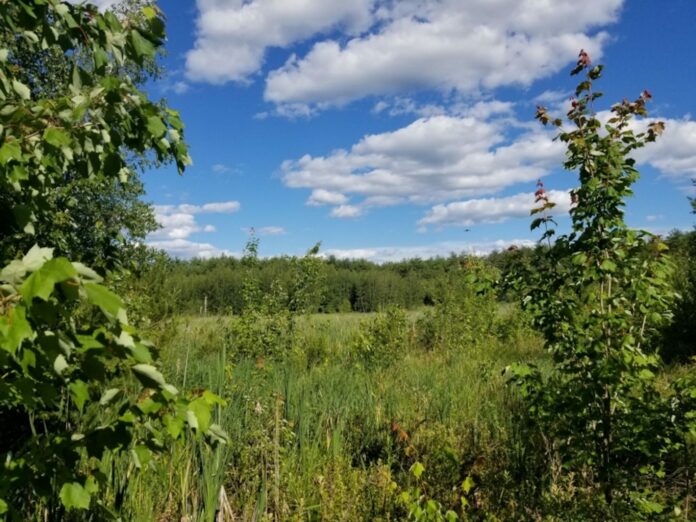Not far from the old woolen mills, shoe factories, and more urban areas of industrial Rochester are swaths of undeveloped land abounding with vernal pools, sandy flats, and remnants of a small 19th-century granite quarry.
Across the street from the Skyhaven Airport, a dirt lot leads to an entry point of the William H. Champlin Jr. Forest, a natural expanse of both woodlands and fields. In the fall, staghorn sumac and a breadth of rich, tangled vegetation greets visitors off the road. Right now, the landscape is covered in pillowy snow.
In a rare instance for any city, the recent purchase of an additional 122 acres of woods and wetlands is boosting the Champlin Forest’s reach, expanding a trail network that will be accessible for roughly 75,000 people across the state’s Tri-City area.
The Society for the Protection of New Hampshire Forests is rejoining the more than 300 acres once owned by Virginia Spaulding Champlin, who donated the land in 2006 in honor of her late husband. Previously home to the Haven Hill Dairy Farm, the land was split by Champlin between the Forest Society and the organization now known as Easterseals New Hampshire.
Through grants, city funds, and individual donors, the Forest Society was able to buy part of Easterseals’ portion to expand the area designated as Champlin Forest. The land is now permanently conserved for public use.
“Properties that are located in proximity to population centers have a higher importance in terms of community recreation value and community wellness,” said Dave Anderson, senior director of education at the Forest Society. “Long term, there’s not going to be a lot of opportunities in the future to nearly double a piece of conservation land.”

(Screenshot)
Land is at a premium as New Hampshire’s built landscape and demand for housing continues to grow. To see a natural resource like the Champlin Forest be not only protected but expanded, conservation advocates and city officials say, is a unique thing.
“We have seen a lot of development, along with the entire Seacoast,” said Ryan O’Connor, senior planner for the city of Rochester. “A lot of housing, a lot of commercial, industrial. Projects like this are pretty important and valuable to make sure this open space is available to everyone and in perpetuity.”
The on-site kiosk sharing information with visitors about the land they’re about to traverse mentions white pine and red oak woods, and wetland breeding habitats for frogs and salamanders. There’s a former beaver dam where Clark Brook enters the forest.
Anderson said he recently found deer and coyote tracks. Other hikers have mentioned raccoons and porcupines.
New Hampshire is the second most forested state in the country, but it’s losing forested acreage each year due to “conversion to non-forest uses,” according to the state’s Forest Action Plan released in 2020. Data from the U.S. Forest Service shows New Hampshire gradually lost more than 126,000 acres of forest between 1983-2017.
On the other side of the coin, New Hampshire has one of the highest percentages of protected land east of the Mississippi River, the state action plan says. The new addition to the Champlin Forest, according to Lori Sommer, wetlands mitigation coordinator with the state’s Department of Environmental Services, “expands protection in a highly developed landscape, results in a connected habitat for wildlife, and furthers mitigation goals to protect water quality of the Cocheco River watershed.”

The city of Rochester, home to more than 31,000 people, is identified as a “priority urban landscape” by the state Division of Forests and Lands, meaning it sees high population density, low tree canopy cover, and potential for future urban expansion.
Preserving the additional acreage will likely have positive impacts on the health of Rochester residents for years to come. New Hampshire’s urban forests are estimated to remove about 5,700 tons of air pollutants a year, a health benefit worth more than $15 million, the state says. And the presence of tree canopy helps with cooling amid a warming world.
O’Connor said the project is exciting not just for Rochester, but for Dover and Somersworth, too, because of the cities’ close proximity. It’s a free outdoor recreation opportunity for a lot of people to enjoy.
“With the additional land, we’re hoping to get more trails out there,” he said. “People use it for hiking, dog-walking. It’s a great wildlife corridor.”
Anna Berry, director of communications and digital outreach for the Forest Society, noted the neighboring land kept by Easterseals will be turned into an affordable housing project for people ages 62 and older. That, she said, is an example of how conservation and housing don’t always have to compete.
